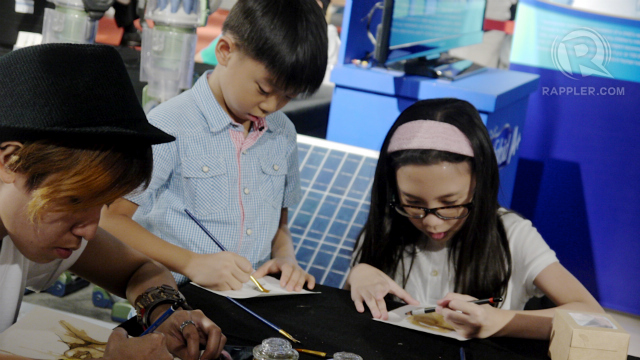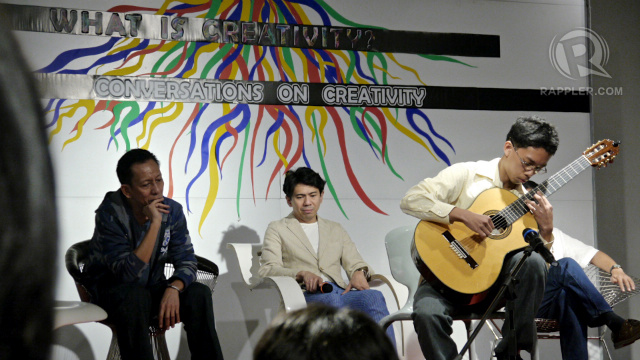SUMMARY
This is AI generated summarization, which may have errors. For context, always refer to the full article.

MANILA, Philippines – I have a confession to make: I’m a closeted DIY aficionado. I can spend hours endlessly stumbling through DIY websites, fantasizing about what to do with my growing collection of recycled jars and popsicle sticks… but don’t even dare ask me to reveal one of my prized pieces, because I am deathly ashamed of the quality of my creations. I’m a “Creative” in spirit, and useless in execution.
It’s a term I use lightly, because I’m also ashamed that I lack the ‘edge’ most people associate with real deal artistas. After all, I like to find new purposes for toilet paper rolls; I never painted a still-life masterpiece. But at this day and age, who has the authority to determine what is creative? Is it a chance idea? Is it a skill? Is it genius? Or do good ideas just materialize coincidentally whenever I take showers?
Left vs. Right brained
Early psychology studies pitted the left and right sides of the brain, and people aligned themselves accordingly: Math-minded, logical and analytical thinkers were told that they were left-brain thinkers, while those excelling in more creative, abstract concepts were labeled as right-brained. But how often do we run into these oversimplified, narrowing statements:
“I’m bad at math, I must be more right brained”
“I like to solve things, I’m a left brainer!”
Innovation in its simplest essence requires both creative thinking and analytical prowess. So where do technological innovators fall? Are they the product of creative genius, or years of training in problem solving and reasoning through the scientific method?
To settle the age-old debate, the Mind Museum assembled a panel of experts in various left and right-brained occupations. As they answered questions on what creativity meant in their respective fields, it became clear that the two math and science based speakers had a lot more in common with the speakers from arts backgrounds.

What is creativity?
Interestingly, all speakers agreed that creativity is a learned skill honed through regular practice and training. Dr. Joey Balmaceda, of UP’s College of Science, referred to it as an un-learning process.
“It’s an attitude issue”, says Dr. Joven Cuanang, a multi-faceted neurologist whose appreciation for science is only rivaled by his love of the arts. All too often, creative zeal is frowned upon as an ailment of “being young” or foolish. It’s adulthood, or at least what many perceive as “maturity”, that stifles creative development.
Dr. Cuanang explains that there is no possible clear dichotomization of the brain. Both hemispheres are connected through permeable white matter, transmitting information to and throughout both the left and right sides. Scientifically speaking, the act of learning is essentially expanding one’s neuron pathways, allowing new connections to be formed in the brain. There’s a tangible and intangible element to learning or having a new idea.
It’s one reason why children are noted for their seemingly endless supply of ideas. They’re allowing their brains to form new connections at rapid fire, uninhibited by “reason” to limit their imaginations. It’s a beautiful thing, says sociologist and theatre director Ricky Abad, but parameters need to be drawn too. We only need to look so far to find plenty of examples where creativity can be dangerous, à la classic labels like the “mad” genius, or troubled artist.
It’s a “controlled craziness”, says Dr. Balmaceda: something that is rooted in open mindedness and freethinking, as well as tertiary functionality. The panel blames school curriculums and a repressive culture that rewards logic over creative thinking.

On becoming more creative
But fortunately, the panel encourages that creativity is a skill that can be developed at any age. It’s an on-going process that requires building upon previous knowledge and allowing new ideas to surface without judgment. Creativity is an evolutionary process. What was considered creative a hundred years ago may not be relevant today, and as times evolve and change, so must we continually create. Moy Ortiz, a performer and composer, dispels the myth that romanticizes creativity as requiring a muse for inspiration. It is a skill that can be willed, but you’ll only get as good so long as you continually practice, says Ortiz. It helps if you’re inspired, but when the deadline’s there and it’s your job as an artist, he advises delivering a satisfactory quality of work if you want to maintain a career in the creative arts.
And as someone with aspirations to forge a career in aforementioned artistic field, I feverishly scribbled the following the words of wisdom imparted by the panel of diverse experts:
How to be creative:
1. Sleep on it, leave it alone for a while, and do something else
2. Learn to be more creative by allowing yourself to un-learn
3. Approach life with an open mind and an open heart
4. Creativity doesn’t happen in a vacuum. Connect different disciplines.
5. It’s a skill that can be honed, so practice it often.
I sat back in my seat among the attentive audience, wide-eyed and absorbing all these collective suggestions on how to “own” my creativity and hone my own brand of ideas, even if they were just pipe dreams (or pipe cleaners, in my case). But whether you’re designing the newest arm of the International Space Station, or noticing that bamboo might be a great material for a new eco friendly bicycle, creativity and creation is an absolutely individual process.
And as a talented young musician from the Philippine High School for the Arts took to the stage to serenade the audience with his masterful arrangement, I found myself more and more relaxed with each melodic strum of his hands; and pleasantly surprised at my own inspiration to write this piece. – Rappler.com
Add a comment
How does this make you feel?
There are no comments yet. Add your comment to start the conversation.